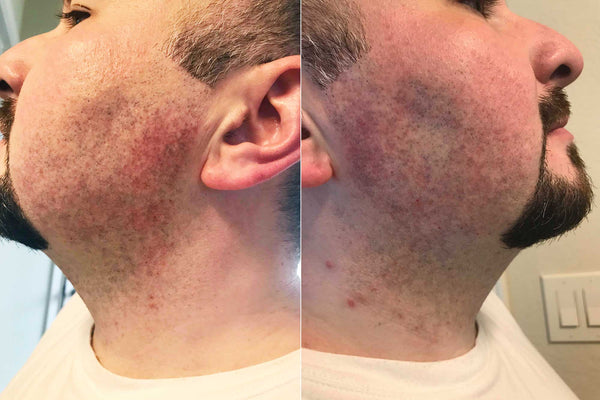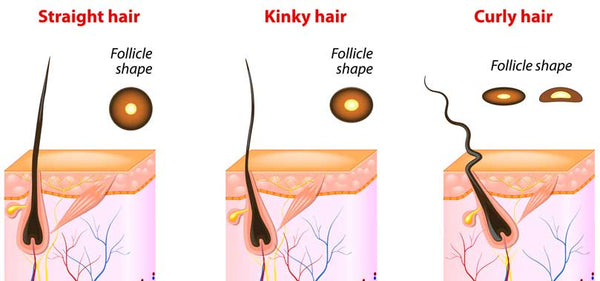
Severe razor burns on Shwan's face.
Razor burns are common symptoms that most people experience after a fresh shave. The itchy feeling on your skin comes from razor burns (red bumps, irritation, rashes, etc.) and dryness due to improper moisturizing or lack thereof. However, a little bit of prep work will help prevent or reduce these symptoms significantly.
Shwan's face in the above picture demonstrates how severe his razor burns used to get from using most common shaving cream and gel. Frustrated with painful shaving experiences, he had no choice but to create a natural shaving soap formula that worked for his skin. To help others like him, he started Men's Soap Company.
Understand the Skin Anatomy
The anatomical terminologies below will be used throughout, so it's important that you know what they are at a high level.

Your skin is the largest living, breathing organ among all organs of your body, and is the first line of defense against external threats. When your skin finds something threatening to your health, it lets you know in the form of side effects such as razor burns. You’re not just cutting hair when shaving, you’re scraping the skin as well. Naturally, blades scraping along the surface and cutting hair rooted within would be considered to be a threat by the skin that would react accordingly.
Do you know your skin type?
Everybody’s skin is different. Skin types are categorized as normal, oily, dry, sensitive, and combination. Regardless of your choice of razor–multi-blade or traditional–their blades will have a varying effect after a fresh shave based on your skin type. If you're just starting out or haven't shaved in a while, you're more likely to feel some reaction at first, as your skin hasn't had enough time to adjust to the razor blades.
Normal and oily skin usually have fewer razor burns compared to dry and sensitive skin. Oily skin may actually be a benefit for shaving, as the oil can assist with razor glide. Pre-shave oil has become popular as of late for that reason. However, oils clog razors easily.
Dry and sensitive skin shavers will require extra protection and hydration, which is why skin preparation for a shave cannot be overstated. You also should consider razor type and lathering agent carefully, because the number of blades and sharpness may be too much for your skin, and the lather may not provide the protection and hydration it needs.
What is the type/shape of your hair?
You may be wondering what hair has to do anything with razor burns. Well, how hair is cut has an effect on the way it grows. Different hair type can have a dramatic effect on bumps and whether they lead to an ingrown.

Kinky and curly hair types are more prone to experiencing bumps and ingrown because they grow in an angle often, which can get caught in the epidermis part of the skin.
What are you using for lather?
A good lather is creamy and has a depth that you can feel when pinched and swirled around between fingers. The lather needs to provide ample cushion between the blade and the skin, slickness for an easy razor glide, and nourishment to keep skin from being agitated.
Furthermore, the lather needs to soften and lift the hair so it is cut cleanly just above the level of the follicle. The chance of hair getting pulled and cut below the skin's epidermis surface is more probable, otherwise.
Have you considered using fewer blades?
You're most likely to be familiar with multi-blade cartridge razors only because that's all you see in stores nowadays. Believe it or not, even with all the comfort strips and fancy swiveling mechanism, multiple blades have several disadvantages that contribute to razor burns.
Fewer strokes and passes mean less irritation for your skin. Multi-blade razors are designed to pull hair and cut multiple times with each stroke, which is supposed to lower your need for multiple passes. If you are using a 3-blade razor, your skin is actually getting 3 mini-strokes with each stroke, creating unnecessary friction against the skin that could contribute to razor burns. Plus, If you end up doing multiple passes for a closer shave, those mini-strokes multiply your chances of razor burns as well.
Can a close-cut shave be too close?
For a close, irritation-free shave, the goal is to cut hair just above the hair follicle level, or slightly below epidermis surface. Multi-blade razors attempt to replicate that with a strip of rubber that's designed to pull the hair and set the stage for blades following behind it to cut as low as possible. The problem is this pulling setup cuts lower than it needs to and possibly introduces re-growth issues.

Theoretically, a 3-blade razor cuts left-to-right manner as illustrated above, where each successive blade cuts hair closer and closer to the skin. Straight hair type fairs better than kinky or curly hair with this method because straight hair will most likely grow back straight, whereas kinky and curly hair types are prone to angled hair re-growth and getting caught in the epidermis, which may contribute to bumps and ingrown hair.
How do you prevent razor burns?
Follow the checklist below, it will serve well for all skin types:
- Hydrate - Your skin needs to be relaxed and soft before a shave. Showering first is the best solution. If you prefer to shower after shaving, cover your face with a damp hot towel for a few minutes. Then, wash with natural face wash and warm water thoroughly.
- Build the Lather - The process of lathering helps to lift and soften the hair. Hair flat on the surface will require multiple strokes to cut, which you should avoid always. Friction is enemy to the skin. We recommend natural shaving soap or cream and a soft shaving brush for lathering. Together, they yield a thick, silky smooth lather that helps protect and rejuvenate the skin.
- Reduce the Number of Blades - Try using a double-edge safety razor, because it uses a single blade that cuts cleaner with fewer strokes, for which your skin will be grateful. Sure, it has a slight learning curve, but you'll get used it just as you have learning to ride a bike or drive a car.
- Shave with the Grain - Shaving along the direction of your hair growth will further reduce the chances of irritation. You may be tempted to go against the grain for a closer shave, but it's really not worth the side effects that may follow. At least allow your skin a couple of weeks of shaves with the grain to adapt. Then, when you do shave against the grain, absolutely take your time.
- Moisturize, Moisturize, Moisturize - Do not leave your skin unprotected after a fresh shave. The blade scrapes away dead skin cells and exposes a fresh layer, which needs to be nourished with aftershave balm or lotion. Again, always choose natural ingredients, as toxins and chemicals found in unnatural formulas will exacerbate the skin.
Those of you with sensitive or combination skin, you may need to try out various razors and blades, and aftershave solutions to find the match for your skin. Our shaving products are backed by a 100% satisfaction guarantee. If you have any questions please contact us, we'd love to hear from you.
